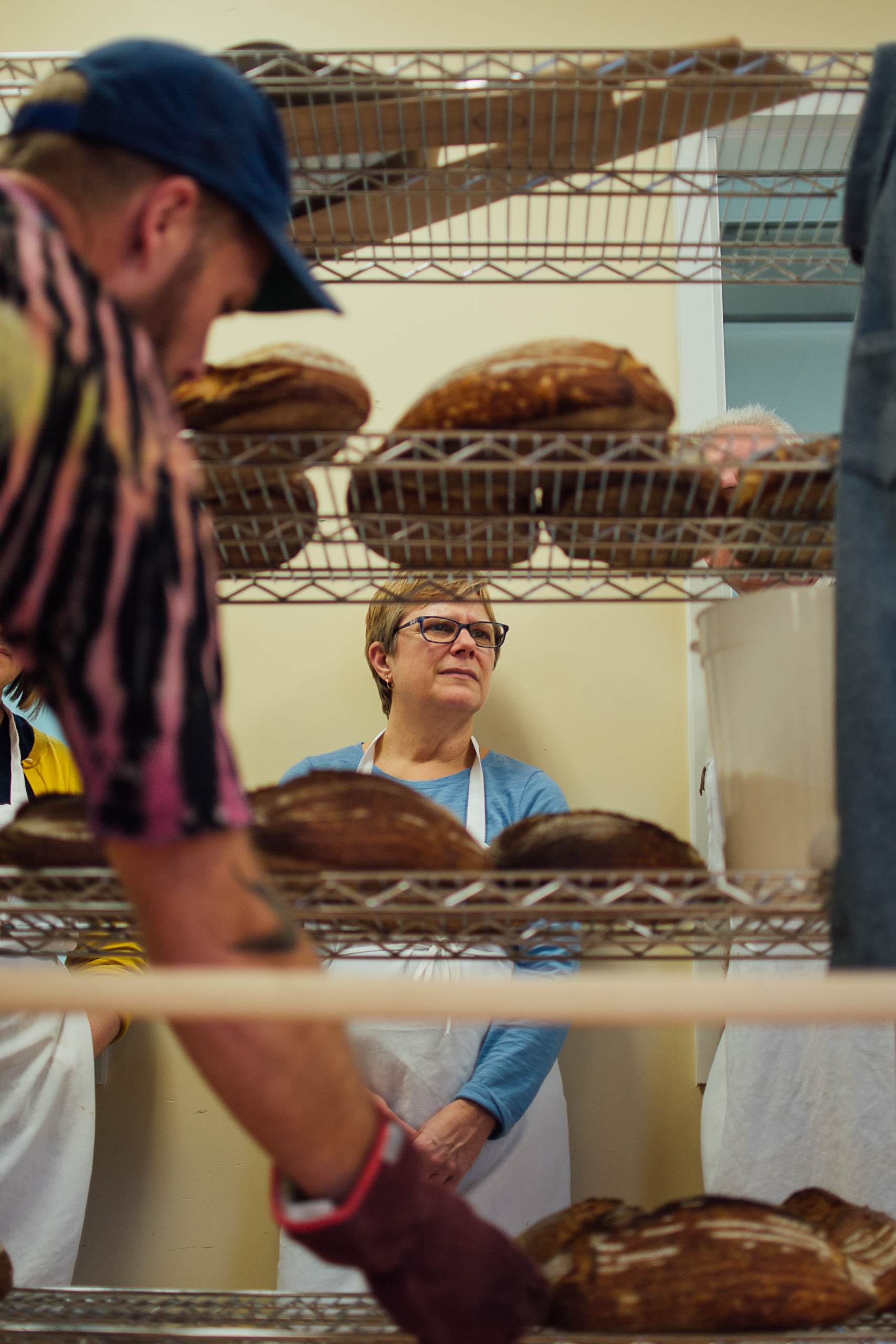I closed my eyes and stood listening to the rough, rhythmic sound of two dozen hearth loaves being shifted from one part of the Miwe triple-deck oven to another. It was surprisingly soothing, calmness in the middle of the excitement palpable in the room.
Our breads were baking! They were beautiful, and smelled so good, deep and golden as the sunlight I was wishing for on this damp Washington day.
A group of us stood close by, watching as Josey Baker (yes, real name!), stabbed a wide, wooden peel into the oven, pulling out our loaves/babies, checking them for color before pushing them in again. The back of the oven was much hotter and Josey was moving loaves around so they would bake evenly. Josey prefers a bold bake, so he was working on getting them to burnished but not too much so.
This was our second day at the new King Arthur Flour Baking School, where Josey was teaching us how to build and bake the types of hearth and pan loaves he sells at his bakery, The Mill, in San Francisco.
The baking school is located within The Bread Lab, in Burlington, Washington, not too far from my town of Bellingham. If you don't know about it, well then, you should get yourself acquainted. Here's a good place to start, or watch Bread Lab Director and wheat breeder, Dr. Stephen S. Jones, as he talks about flour here.
Dr. Jones visited during our second day and walked us over to the test kitchen, where we yes, talked flour, and got to see all kinds of milling equipment, from a German Mock Mill you can attach to your KitchenAid mixer to a large wooden beauty of a stone mill called an Osstiroler from Austria.
Then there was the equipment they use to test the different qualities of flour, such as for gluten strength as well as starch and protein levels. Wow. I was starting to feel like a little kid; I was jumping up and down inside.
Thing is, being a home baker, I don't get many opportunities to talk to people in my daily life about protein content, oxidation and milling practices without them glazing over (or actually nodding off, yep), so this was it. I finally felt like I was with my people.
After this, we also got the chance to visit the new stone mill that is being built around the corner, in conjunction with Camas Country Mill , the Port of Skagit and Patagonia. From the outside, a non-descript warehouse building greeted us, but once inside, a beast of a mill, with parts from Denmark, Ethiopia and Kansas sat impressively before us.
Here's Tom Hunton, farmer and owner of Camas Country Mill, who was there talking to us about the new mill, the disappearance of regional mills throughout the country, farming and milling practices, and his desire to sustainably feed his community.
Knowing about the flour you use as a baker is so crucial, but isn't necessarily something the typical home baker thinks about. But we should! Who grew the grain where and using what practices? Was it sprayed with Round Up before harvest? How was the grain milled? And wait, back up, is it a genetically modified variety? Surely these are questions worth asking if you want to make bread that feeds and nurtures on all levels.
But back to the actual bread making. We made three with Josey: his Country Bread, Red White and Rye, and his Dark Mountain Rye, a 100% rye loaf crammed with rich, toasty seeds. Because I haven't baked much with rye, which he assured us has a much smaller margin for error than wheat, it was especially helpful to learn Josey's process.
Rye dough looks like cement! Especially when you make 24 kilos of it, like Josey did! Take a look:
Because rye is very low in gluten, a 100% rye dough lacks structure and needs to be baked in a greased pan, unlike the wheat doughs, which we shaped, proofed in bannetons and baked directly on the oven hearth.
The combination of actual hands-on practice and learning principles, as well as the information about flour and milling practices, was just right for me at this point in my bread baking journey. It was also a huge treat to visit the new mill, see the test kitchen, and hear Dr. Cole and Tom Sutton speak.
One of the most helpful things Josey taught us was how to pre-shape and shape the dough. After dividing it once the bulk fermentation is complete (I'll go over this in a future post), he tucks the bench knife under the piece of dough, metal edge facing away. Then he simply pushes the bench knife (and thus the dough) in a J-shape ("J like Josey!" he said), flicking it away from the dough at the end of the movement.
As if by magic, the once globby piece of dough suddenly looks taller and slightly rounded. A few more times of this, and the dough has real shape, all without any manhandling. Genius!
I'm incorporating everything I learned as well as using the rye starter I got from Josey into my bread baking here at home. A big thanks to Josey Baker, who is a kind, generous, and totally cool teacher! You're the best!











